While doing a somewhat random search on Amazon a few weeks ago, I stumbled upon a radio with a model number that I didn’t recognize–the Kaito KA29.
The form factor of the KA29 is very reminiscent of the Degen DE1129 I reviewed two years ago, but it’s smaller and sports a number pad on the front. On a whim, and with possible use of this radio in my charitable work at ETOW, I purchased one. At ETOW we have used similar radios with 16-32 GB Micro SD cards, chock-full of educational audio content. At $35, the KA29 is an affordable MP3 player and radio.
On a side note, I suppose I should mention that I was pretty disappointed with the DE1129 because I had hopes it would make for a great all-in-one portable radio recorder for ETOW. While the DE1129 could record FM/AM and SW radio directly, it had serious problems: it auto-adjusted the volume level during recording (one could not turn off the internal speaker), it degraded audio quality in recording, and medium wave was plagued with a “ticking” sound every 10 seconds. It produced digital hash on various meter bands. My summary of the DE1129: fine concept, poor engineering. Read my full review of the first version of the DE1129 here.
The Kaito KA29: First impressions
The Kaito KA29 is a cute little portable. Mine has a black body with orange band encircling the diameter. That orange band is actually a nice addition–it helps the radio show up a bit better and makes the ports a little easier to see when lighting is low.
The overall quality of the radio feels fine: the hard plastic body has a smooth matte quality and the buttons have a very tactile response. The telescopic whip antenna is long for the overall radio size, but is still a little on the short side for good HF gain. Oddly, unlike most radios, the antenna cannot swivel at its point of attachment to the chassis; it can only be extended and tipped side-to-side–but not front to back, or back to front. Like the DE1129, the KA29 lacks a back stand–a big negative in my book–but admittedly a back stand would be of little use while SWLing with this rig because the antenna can’t be swiveled or tipped into a useful vertical position. Hm. Also like the DE1129, the KA29 uses a slim rechargeable battery pack.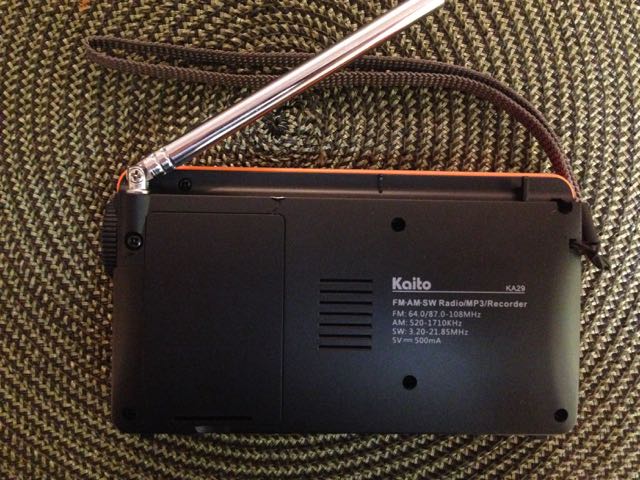
When I first turned on the KA29, I thought I had received a faulty unit: I pressed and held the power button for a second, the display lit up a bright green, I released the power button…and the unit turned off. After a little trouble-shooting, I realized that the KA29 requires holding the power button a full two seconds, until the “Kaito” brand name appears on the display.
This sluggish power-up response is truly an indicator of most functions on the KA29. It’s as if every function is controlled by a slow processor–which I’ve no doubt is the case.
As far as I can tell, all the menu functions are the same on the Degen DE1129; obviously, they’re built on the same firmware. Indeed, Kaito is the North American brand for the Chinese manufacturer, Degen; the Degen model number for this radio is DE29. In this sense, most functions are familiar to me.
Tuning
The one added feature of the KA29 that my version of the DE1129 didn’t have is a number pad, useful for direct entry of radio frequencies. I should note here that I (typically) toss the owner’s manual aside when I first get a radio, in order to test how intuitive its functions are. I spent quality time with the KA29 while traveling a few weeks ago, and as I didn’t bring the manual, I had to learn its functions via trial and error. It wasn’t until I returned that I learned how to use direct frequency entry; the is answer clearly stated in the manual: just key in the frequency, then press the appropriate band (AM/FM/SW) to go to that frequency. Pretty simple, actually. The response time for the radio to start playing the frequency you enter is only about one second.
Use of the tuning knob (located on the right side of the radio) is easy and straightforward–tuning up and down will move the needle 5 kHz steps between frequencies. Unfortunately, as on the DE1129, 5 kHz is the smallest tuning step available. The KA29 briefly mutes between frequency changes, so when tuning slowly it’s very noticeable. If you tune quickly, the KA29 will produce snippets of audio as you pass signals, but I find it often skips over even very strong signals. In short? Though I suppose it could be worse, I do not like tuning the KA29.
I should also mention that the KA29 has no adjustable bandwidth; I’m guessing the AM bandwidth is stuck at around 6 or 7 kHz.
Performance
While I no longer have the DE1129 in hand for side-by-side comparison, my impression is that performance between the two radios is very similar.
Audio fidelity
Herein lies the strength of the KA29. It obviously uses the same speaker technology (with an acoustic chamber) that the DE1129 uses. You will be favorably impressed with the audio from this wee radio–it is quite robust for a pocket radio of this size, and in a small room, almost room-filling. It sounds fantastic on FM and AM alike–you can even hear a hint of bass. One day, I tuned the KA29 to a local AM station and listened quite comfortably in another room. Impressive.
But what about receiver performance?
FM
FM performance is quite good. I’ve used the KA29 in two different cities, and found that it could detect most of the same FM stations my other portables picked up.
AM/Medium Wave
I was pleasantly surprised to note the absence of the annoying ticking sound I heard in the DE1129; it appears Degen engineers have succeeded in eliminating this distraction. In general, I believe the KA29 performs acceptably on medium wave for basic local and nighttime clear channel broadcast listening. The AGC circuit is not ideal, though, for any sort of medium wave DXing; don’t consider the KA29 for MW DX.
Shortwave
If the KA29 is better than the DE1129 on the shortwave bands, the improvement is negligible. You’ll be fairly happy with the KA29 while listening to strong shortwave broadcasts. During my review, I listened to the new Global 24 a few hours on 9,395 kHz–an easy catch on the east coast of North America–and the KA29 was fairly stable, producing rich audio.
Here are the cons on shortwave:
Automatic Gain Control
While listening to weak stations, you’ll discover the KA29 to be somewhat sensitive, but again, the AGC circuit is just too active to listen comfortably for very long.
Noise floor
The noise floor is more obvious while listening to weak signals: I believe much of the noise is coming from the internal electronics of the KA29. It produces an audible digital hash sound that makes weak-signal listening a bit of a chore.
Images
Quite often as I tuned around the shortwave bands, I noticed that FM stations bleed through the audio. Check out this audio sample as I attempted to listen to Radio Ryhad:
Indeed, even if the shortwave station has a relatively strong signal (like this recording of Global 24) you can often hear noise:
For comparison, listen to the other radios I recorded at the same time for the ultra portable shoot-out.
Onboard Recording
Fortunately, several of the recording problems I noted with the DE1129 are no longer an issue with the KA29.
Fixed volume
The DE1129, when recording radio, had the exceedingly annoying habit of automatically setting the internal speaker’s volume to a high level. While recording, this could not be changed.
Fortunately, this problem has mostly been addressed in the KA29, which does not increase the volume while making a recording, but still fixes the volume at the level set at the recording’s start. I didn’t find this to be much of a problem.
Audio quality
The recording performance is better than that of the DE1129, which produced noisy, muffled recordings. The KA29 will produce fair audio recordings on AM, on FM, and on shortwave. One drawback: you will note a low-volume, high-pitched static noise–a hiss, to be specific–inherent in every radio recording, regardless of band. While it’s not too offensive, nor enough to deter me from making direct radio recordings (at least of strong stations), there is still much room for improvement. Obviously, I can use the headphone jack and an external digital recorder to make better radio recordings. But the convenience of an all-in-one recording device plus radio outweighs the slight hiss in the internal recordings it produces.
All in all? I’m reasonably pleased with the radio recording capabilities of the KA29, and the improvements it’s made over its predecessor. If the Degen engineers could lower the KA29’s noise floor and fix the imaging problems, and add 1 kHz tuning increments, this could be a good value all-in-one radio, a real contender.
Summary
Ever radio has its pros and cons. The following is a list I made while reviewing the KA29:
Pros:
- Keypad entry
- Great audio for a tiny radio
- FM reception quite good
- MP3 playback audio is good
- Onboard radio recording acceptable (see con)
- 9/10 kHz select-able medium wave steps
Cons:
- Sluggish response to most actions; if (for example) volume control has been used, you must wait nearly 4 seconds before using another function
- Awkward menu to navigate
- No bandwidth selections
- Imaging on SW bands
- Fixed 5 kHz steps on shortwave
- No adjustable bandwidth
- Digital noise on portions of MW and SW bands
- Low audio hiss present in all internal radio recordings (see pro)
- No back stand
- Antenna does not swivel 360 degrees for optimal placement
Conclusion?
If you’re looking for a pocket radio to make local radio recordings on-the-go, and the quality of your recordings is not a major concern, you might give the KA29 a try; chances are you’ll be fairly pleased with the affordable KA29.
If you’re a shortwave radio hobbyist or DXer of any stripe, however, don’t waste your time or money on the DE1129. Instead, pitch in $10 more and buy a Tecsun PL-310ET–it has no MP3 recording or playback, but it will receive circles around the KA29.

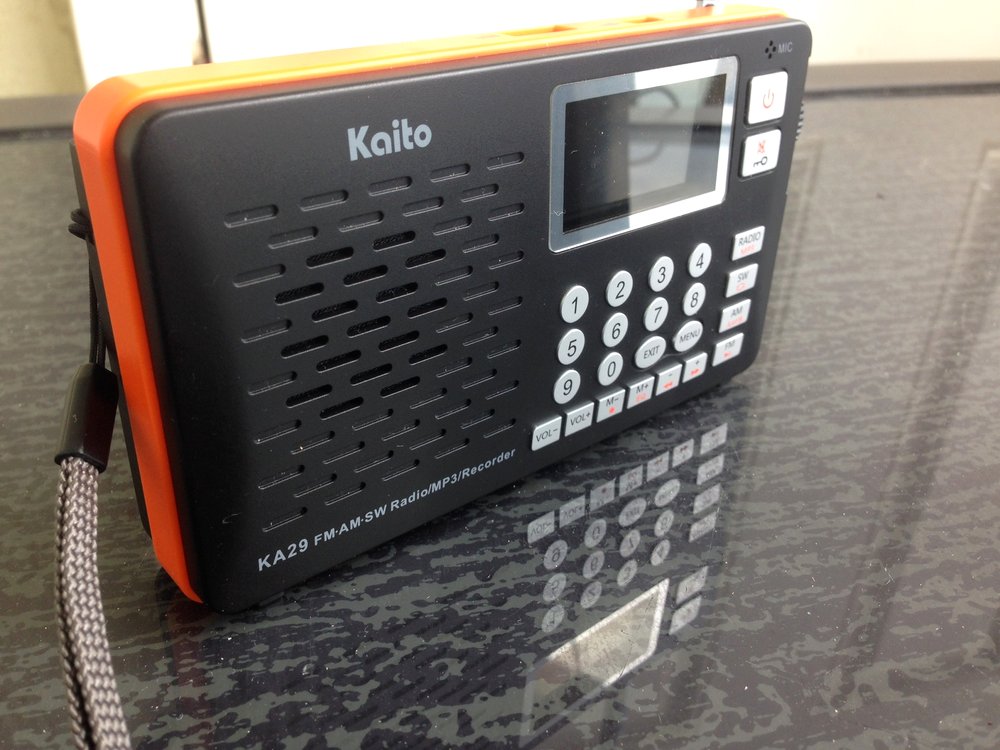
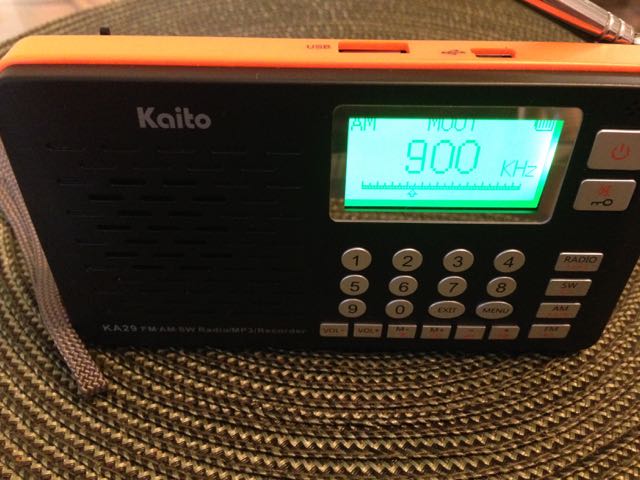
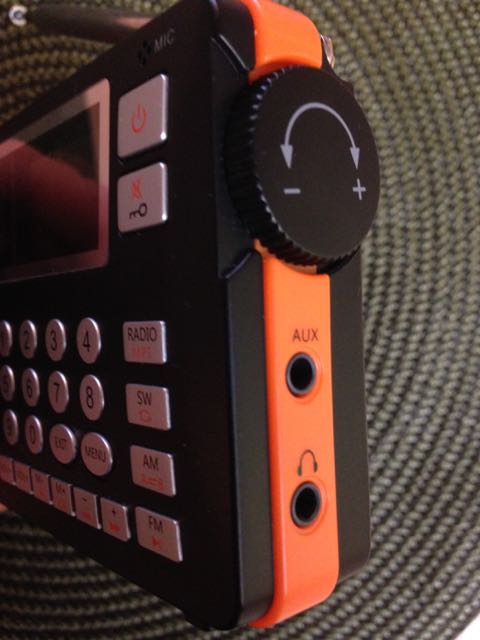
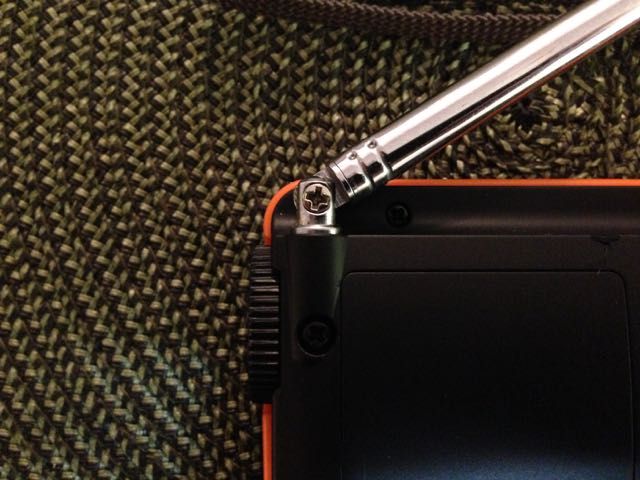
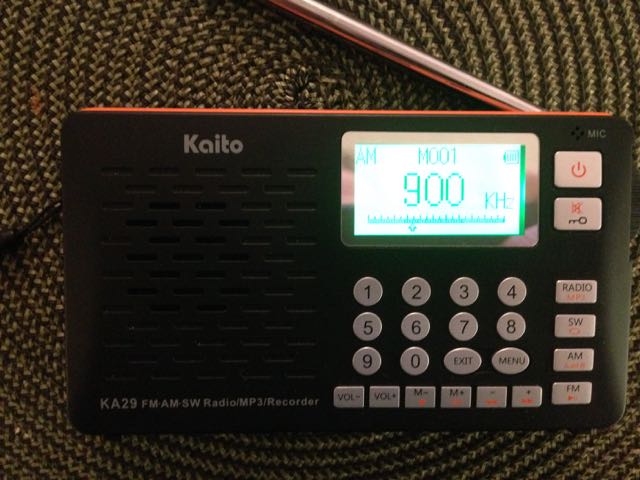
Can you kindly let me know how to open the battery compartment to change the battery. I tried my nail, but that doesn’t seem to work. I hate to break it, but I’d like to put another battery in it.
Does the ka-29 have a Line-in to record from another radio, or device such as the out from my phone into the ka-29 and how long is that recording Time? Does the card need to be formatted for this unit? And if so how do you do it.
Try the Aux jack.
Hi.
I’ve had a KA29 since 2015, and purchased it not long after reading this review. You mention that on your model, the antenna doesn’t swivel and can only be extended outward and moved left or right.
On my model (the white and blue colored one), the antenna does indeed swivel to a degree. You have to extend the antenna while nearly completely laid down to the left or right,, and pull the antenna toward you. You can only swivel it 180 degrees since the plastic housing prevents it from going a full 360, but you can at least partially swivel the antenna.
Thank you, Wade!
I purchased degen de 29 radio but on several request the operating manual in ENGLISH could not be provided to understand its function. Can you provide on interent.
Can you download from Amazon music to the ka29? If so, do you use the USB card? I am clueless even after reading the instructions.
i liked your review. I own K29 and i like it. yes it is not for continous coverage and jumps in 5kHz. My radio came with the user manual and at this point i want to talk about a correction in this review.
the antenna can be turn around front and back, to the front limited by the plastic case position, but to back, you can swivel from vertical to minus 15 degrees and rotate around.
considering the desing was made for broadcasting reception i think it is a good, very portable and incredible audio for this size, radio.
the cons, some noise and the slow processor.
Hi Thomas,
Just a question about the H2N, that I’ve been wondering about.
When using it to record at a concert, does it really record well even though the sound is coming from the speakers?
I’ve heard recordings on YouTube of live band performances, and some of them are good. But just wondering. If a band is rehearsing, then it makes sense to me that it records well.
But when at a concert, and the sound is coming from the speakers, will it really be good? And if so, why is it good? Don’t the speakers reduce the sound quality a little?
Sorry about not getting back to you–I’m notoriously bad about forgetting to reply to comments especially while I’m traveling.
I recorded at least two live concerts in a medium size venue for my buddy, BJ Leiderman. BJ took my recording and used it to mix with the recording coming off the board–mixed, it sounded like a proper live concert.
I simply put the H2N on a boom type holder above the audience at the back of the venue with the sound guy. I ran it in 4 channel.
You will have to experiment. Some venues lens themselves well to recording, others not so much. You should monitor the recording the whole time and make adjustments when necessary.
Clear as mud? 🙂
Have you come across a device that will allow you to pause live am radio so that you can sync it with a live TV broadcast?
A few quick questions:
I haven’t downloaded Audacity yet, will do so.
1. I just played the files I recorded on my PC. The volume is lower than I thought. However, when I had been monitoring these radio recordings through my headphones, it seemed loud.
Can I use Audacity to increase the volume, as I split off a portion?
2. The time stamp of my audio files are messed up. I think they’re off by 12 hours AM/PM wise.
Ok, now I see. The time is set using 24 hour time.
I wish the instruction booklet, or the UI, had been more clear that the time was in that format.
If you’re using the Zoom digital recorder to make the recording, make sure your recording level is high enough. It may be that your recording level was low, but the recorder monitoring volume was high as you made the recording. This would result in lower audio levels upon export.
Make sure your audio level indicator is pegging the higher side of the indicator without clipping the audio. You might check for a tutorial online.
I’m sure you could increase the audio level via Audacity. It’s always best to have the level correct in the beginning, though.
Keep tinkering with the mic gain and your headphone levels and you’ll soon sort it out!
Best,
Thomas
Hmm, I’m not bringing headphones, as I can’t carry that much stuff, and it’s too much to bring.
I guess I will have to experiment a few times.
For stereo, does it also depend on the conditions and position as whether to use X/Y or MS? Or if you do stereo, it’s always MS?
Thanks.
I wasn’t sure whether there was an option for mono, because I didn’t come across it in any of the reviews or YouTube reviews I researched. But now that you said it’s possible, I will use this.
When reading about the Tascam DR-40, some reviews explicitly mentioned mono as an option.
So, when recording from AM radio with the H2n, I will use mono, now that I know it’s possible.
For live recordings, would MS mode @ 96 kHz be the best? 4-channel or 2-channel? Does it depend on where I’m positioned? Would MS mode still be ok if I was off to the side? I usually am on the floor, so I go where I have the best view. Sometimes that’s center, but other times it’s on the side.
Yes, I came across the accessory package. I thought I’d get it at some point, just didn’t want to get it at this moment, as the H2n + 32GB memory card + 3.5 mm audio cable were enough of a purchase at this moment.
I agree the windscreen in that package is a must. But the package seemed to be missing a hot shoe? I want to be able to mount the H2N to my camera, just above it. My camera currently does not have a hot shoe mount, but I have a good idea of what I want for my next camera, and I also confirmed yesterday that the model I’ve been looking at has a hot shoe slot.
This past week has been quite a bit of learning for me. As I never thought about digital recorders before. Nor did I know what a windscreen, nor hot shoe were. But after seeing how people use them, and seeing how I could do some of the same things, it’s making sense.
So for now, I would use the digital recorder at a concert in my hand only, and for 1-3 songs at most. I don’t want to divert my attention too much. But in the future, I’d mount it to a camera (and not have it in my hand).
Thanks again for all of your help this week.
You’re most welcome.
Just a couple of notes:
I actually record everything in stereo, but change it to mono via Audacity. I don’t think it can record mono natively, but perhaps I’m wrong.
In terms of how to record a concert it completely depends. I’ve recorded in stereo and four channel depending on the position of the mic relative to the band. I always monitor with headphones and pick out the pattern I like best.
Cheers,
Thomas
Nevermind, I take it back.
I listened to some of the same YouTube clips for live music, this time with good headphones.
Some of them sounded much better, and I’d be happy with the recording quality.
I did think that when noisier bands were recorded, or bands with many instruments, that the vocals were usually a little buried for my tastes. The vocals weren’t quiet, but they weren’t loud either. But, there can be different factors for that, such as where the H2N was placed; and the conditions of the environment; etc.
I’ve recorded an interview on my Zoom H2N that was used in a professional radio production. They’re quite amazing devices–especially for the price.
Honestly, recording line-in audio from an AM signal is a fairly lo-fi process. I usually record in .WAV mono, but then convert to MP3 for distribution. I typically make the conversion to a 128kbps MP3. Frankly, that’s probably overkill for an AM off air recording, because the audio bandwidth is well within the limits of the format.
If you’re planning on using the H2N for anything live (like a concert), I would invest in this package: http://amzn.to/1TFaTAj
I purchased this package; the grip and windscreen are a must. The case works very well, too.
How do you like the Zoom H2n for live music?
After listening to some samples on YouTube, I think it’s ok. But I don’t think it’s so great that I’d appreciate the details of the audio quality when listening to it later. Right now, it seems more like an improvement over camera or phone mics to capture audio, but I’m not sure the 96 kHz WAV would bring the details that I’d expect from a lossless format. I don’t know if I’d get it and think wow, the quality of the recording is great.
Maybe I just haven’t listened to the right samples. Or maybe it’s because it’s YouTube quality.
What file format would you recommend (96 kHz WAV or a 320 kbps mp3)?
I would think for radio recordings, 320 kbps would be fine.
But if I were to take this to a concert (seems portable enough to fit in a pocket, WITH a camera in the same pocket), then 96 kHz WAV? If I were to take it to a concert, I’d probably do 2-3 songs at most. I’d spend the rest of the time, simply enjoying the performance, or taking pics. I don’t want to get too distracted and record a whole show.
Would I use MS mode, or XY mode (if I get the H2n)? Or would that depend on my placement? If I’m center, I use one mode. If I’m on the side, I use another?
I think you would only need the H1 for line-in recordings from the PL-600. The only reason I upgraded from an H1 to an H2N is because I actually record live interviews from time-to-time. The audio quality (between the H2N and H1) is similar on line-in recordings if not the same.
With the H2N, by the way, you can’t use 2 and 4 channel surround on line in recordings.
Hi Thomas,
Thanks for your review. A few questions:
1. Does the KA29 come with internal memory, or is it all written to a microSD card? What is the maximum capacity microSD card it can take?
2. How much space does a recording take? For example, how much space would a 10 min recording take?
Could I also record 5-6 hours? How much space would that take?
Is there any software you recommend that can extract a portion of an audio file (that I’d specify the time parameters)?
3. I currently have a Tecsun PL-600.
Would you recommend I get another device (such as the KA29)? Or use some kind of Android audio recording app on my phone, and record playback while my Tecsun radio is playing? Those apps might have some file size or time limitations. Or the audio quality might not be good.
What did you use to record during the Ultra Portable Shortwave shootout?
https://swling.com/blog/2014/11/shoot-out-results-top-ultra-portable-shortwave/
Is there another device you’d recommend for radio recording (rather than the KA29)? Or another method?
For now, I plan to record AM or FM radio. But who knows, I could expand that in the future to SW.
4. I’ve been curious about SW stations. But I don’t know where to begin, to find broadcast schedules.
I tried searching a bit a few years ago, but couldn’t find anything helpful.
How can I find what stations I might be able to pick up with my PL-600, and what time of the day those broadcasts will be, in West Coast (PST) time? I live in the Bay Area in California, if it helps.
Can you help?
Even something quick, such as specifying a time, day of the week, and station to listen to on SW, where I’d be able to hear something, would be a great start.
5. On another topic, I am also looking into getting a portable cassette player, because as part of a concert package, a band is providing a demo cassette tape.
Is there some kind of a portable all-in-one cassette player and digital radio recorder you recommend?
Or should I get a separate device for the cassette player?
I’ll try to answer what I can for you–in truth, I’m short on time to actually dig into the KA29 to answer all of these questions. 🙂
I’ll try to answer according to your question numbers:
1. Audio files, etc. are written to the Micro SD card. If memory serves (me!) I don’t think there is substantial built-in memory for anything other than basic radio functions (perhaps to mark frequencies to memory–something I don’t typically do).
2. MicroSD cards are very inexpensive. You could probably store several weeks worth of recordings on one 32GB card. The files are compressed and don’t take up much space.
I use Audacity to edit audio files–it’s free and there are several YouTube videos showing how to use it.
3. I use the Zoom H2N: http://amzn.to/1f1qH2F I’m sure there’s a way to use an Android device to record as long as you have a line-in on your device. I imagine you’ll risk a little extra noise in the recording, though. I’ve never attempted this myself as I prefer stand-alone digital recorders like the Zoom series.
4. Check out my tutorial here: http://swling.com/
Read through this and it’ll teach you how to find stations.
Note that we’re currently experiencing some wacky solar conditions which negatively impact shortwave listening conditions–especially during the day. If you scroll down the right sidebar of my blog page, you’ll see a small graphic which describes today’s current propagation conditions.
Also, read this tutorial on how to maximize your listening experience:
https://swling.com/blog/2014/05/frugal-swling-investing-little-but-getting-a-lot-out-of-your-radio/
5. Perhaps someone else can chime in, but I know of no audio player/recorder that has both cassette and digital playback/recording capabilities in one. You can still find analog (cassette) recorders on eBay and musician sites, but most recorders sold today are digital. There are certainly no shortwave radios with built-in digital and analog (cassette) recording capabilities. I would simply use a basic digital recorder with a line-in jack for recording from a cassette or from the radio. You can use the headphone jack on your PL-600 (which is a better receiver than the KA29) to record to a stand-alone digital recorder.
In general, the KA29 does an OK job recording from AM and shortwave. It’s not a brilliant radio though, as my review states.
Cheers,
Thomas
Hi Thomas,
Thanks for the detailed responses.
I think your tutorial can help me get started.
How would you compare the PL-600 vs. the PL-660?
Ok, since I don’t need another radio, a standalone digital recorder is a better idea. So instead of the KA29, a digital recorder would give me more performance and features in terms of what I actually want to do, which is record audio.
I see there’s a Zoom H2n, and a Zoom H1. But that the H2n allows for “pre-recording”. Does that mean I can set a schedule of when I want to record (start/stop time)? If so, that is a very desirable feature.
You’re also suggesting I use the headphone jack of the PL-600 into the digital recorder. If I do that though, I won’t be able to hear what’s being played / recorded, right? I also want to be able to hear what’s recording.
Perhaps instead I would have the radio playing, and use the recorder to record (without connecting it).
Hmm, is it possible for the recorder to record from the PL-600, and for me to hear what’s being recorded, but for it to also NOT pickup background noise? So if I’m listening and recording from the radio, I wouldn’t want it to pick up sounds of me walking around or typing in the background, haha. If I can avoid it.
Lastly, as for the cassette player, I guess since I only need it for playback, I will look for some analog cassette player.
Thanks again for responding to all of my questions.
I’ve never used the “pre-record” function on the Zoom H2N, though it could come in handy. It’s not a scheduling feature, though; it’s used by people capturing live sound either via the line-in jack or microphone. Here’s a quote from the owner’s manual:
“When pre-recording is on, this recorder can continuously capture two seconds of sound before recording is started manually. When is pressed, these two seconds are included at the beginning of the recording. This is useful when, for example, performances start suddenly.”
Here’s a download link for the PDF manual:
http://bit.ly/1P3rtbz
If you use a line-in connection from the PL-600 to the Zoom H2N, you can monitor the recording with headphones plugged into the H2N. If the PL-600 (or any Tecsun for that matter) had a proper line-out jack, you could even monitor the recording via the radio’s internal speaker. Unfortunately, few portables have a line-out; one of the reasons I love my Sony ICF-SW7600GR.
If using a line-in connection, the Zoom H2N disconnects its microphone, so no ambient noises will be captured in the recording.
Regarding your question about the Tecsun PL-600 vs. PL-660? The PL-600 is a great radio, but I certainly use the PL-660 more often because it has better sensitivity and sync detection. My advice? Use what you have now and invest in a stand alone recorder. Later, you can upgrade receivers.
I hope this helps!
Thomas
Thank you!
Random question: Does your Sony ICF-SW7600GR allow you charge rechargeable batteries within the device, like my Tecsun? And if so, while its charging its batteries, can you listen to the radio? The Tecsun doesn’t allow you to listen to the radio while its charging its batteries, which is a small inconvenience sometimes. I use rechargeable batteries in it.
Would you recommend the H2n or the H1? And why? There’s a comparison chart near the bottom.
http://www.amazon.com/Zoom-H2N-H2n-Handy-Recorder/dp/B005CQ2ZY6/ref=sr_1_1?s=musical-instruments&ie=UTF8&qid=1439308040&sr=1-1&keywords=zoom+h2n
And what file format would you recommend (96 kHz WAV or an mp3)?
Thanks for the link to the manual, I looked through it a little.
In addition to my questions above from yesterday:
If the difference between the Zoom H1 and H2N is audio quality, given that the source is the Tecsun PL-600 radio, would I be able to tell the difference in audio quality? Especially considering some of what I would record would be AM radio.
And if I got the Zoom H2N, would I use 2 channel audio mode? The options are X/Y, Mid-Side, 2-channel surround and 4-channel surround. I don’t think I’d get surround sound, but just wondering if that’s what the best setting is for the job.
Is it also possible to use a digital recorder to enhance video recordings? If I use a line out on my digital camera (I have to check if it has one), or the headphone jack on my phone, while recording video, and feed it to the Zoom, then it would it would use the Zoom’s audio recording in the video file, right? I’m trying to think of a few different ways I could use a digital recorder. To make sure this is something I could apply a few different ways, from time to time. And not just have it be a limited use device.
I bought the KA29 2 days ago, but I could not find the manual on the net… I would like to read it before I receive the radio, would it be possible for you to send it by mail. Merci de la part d’un de vos lecteurs du Québec (Canada).
I thought I would purchase the Digitech AR 1945 portable gen coverage receiver that Jaycar electronics stock.After reading a few disapointing reveiws,I thought I may aswell see for myself if the very poorly functioned SSB mode is true.Well upon buying it,the first thing I did at home was to put it through all its paces.AM/SW,FM and VHF AIR was excellent.The VHF AIR Band acturly scans.But yes the SSB section was indeed very poor.I tried everything I could think of to improve this.As Im a very serious SSB DXer,Im more interested in following Planes and Marine HF etc.For a start,I did not like the type of Antenna input socket at the back.It was the type you would connect a UHF TV antenna to.So I drilled out a large hole on the back of the case,big enough to take a Coaxal socket,the type that Ham radio gear use.I then fitted and soldered wires from the other antenna terminals to the socket.I have my 100 ft long line connected to it now via a coaxal plug and coaxal lead.Really good results,acturly far better than useing the supplied fitted antenna terminal.But one thing,since this has fully digital tuning,and a number of tuning steps to refine your tuning,you do need to be very paitent,and use the DX and Local settings switch.Its full of all the Bells and Whistles,and everything does acturly work.But dont be in a hurry to
tune in a SSB station.If you know the correct frequency you want,take a little time and you will get very good results!
Brilliant article, thank you! It got me thinking: is it too much to ask of Santa to give us a Tecsun PL310 ET Mark II that would have
– an SSB capability
– onboard MP3 recording to an SD card
(Tecsun, I hope you’re reading this!)
Another thing I have notice recently with the newer shortwave portable radios hitting the market this winter, is that they seem to be just a repackage of an older design with some minor firmware changes. Example is the new lineup of Grundig radios under the Eton name. All four new radios appears to the old Grundig design with a new case and a few firmware changes. Kaito and Degen appears to be doing the same thing. Not that there is anything wrong with that concept.
I like the new security feature of the comments. I can almost get it right the first time every time. :0
Another Tom
Another excellent review. Your review was so inclusive of all the details about this radio, I decided to not even do a review of this radio on my YouTube channel as my review would be mundane compared to this review. On the other hand, I do plan to purchase one of these radios for demonstration of the radio in actual use.
Thanks again for your devotion to our hobby,
Another Tom